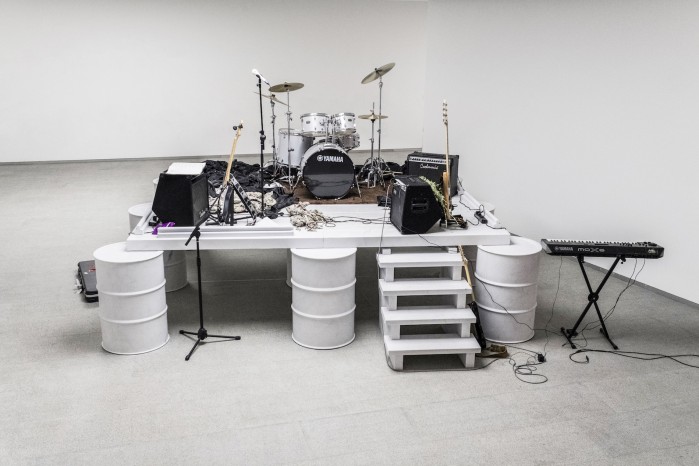RIRKRIT TIRAVANIJA ANTWERP ROAST
Rirkrit Tiravanija is widely recognised as one of the most influential artists of his generation. His practice defies media-based description combining traditional object making, public and private performances, teaching, and other forms of public service and social action. In a market-driven art world, he has remained, since the early ’90s, a steadfast conceptualist whose immaterial projects, enmeshing daily life and creative practice, have earned him a key role in the development of relational art.
The starting point of the exhibition at Tommy Simoens, which consists of five projects, is Tiravanija’s interest in Gordon Matta-Clark’s relationship to Antwerp and the work he did in this city. “When I had the opportunity to make an exhibition here, I asked myself how I could do something in this gallery context that would make sense to me”, Tiravanija explains. “So I thought, alright let’s close up the gallery completely by bricking it up. Which installs a situation where one has to penetrate in the gallery’s architecture, in order to reclaim its function. It’s a kind of anti-architecture for galleries.”
Matta-Clark cut through entire buildings, started to sculpt them, revealing the building’s social structures by opening them up and cutting holes all the way through, and bringing the private spaces of the buildings into the public space. By closing up the gallery, Tiravanija took the opportunity to do the same in reverse. Physically closing down a gallery quite brutally reveals the range of a gallery’s role in society. Neighbours start wondering, visitors and collectors get anxious, the gallery staff, the artists and the many people involved in making a gallery work all of a sudden lose their main working place. Showing and selling art stops, communication and meeting people is no longer possible. By making the gallery inaccessible, Tiravanija effectively shut a small community down, and literally banned everyone involved to the streets.
At the same time, Tiravanija brought the streets into the gallery. Local Antwerp graffiti artists were invited to come and use all of the gallery’s space, before the gallery was completely shut. The artist provided a list of all the specific titles, or ‘slogans’ he has been using in his work throughout the years, in performances, t-shirts, wall pieces and paintings. Tiravanija describes them as road signs: “It’s as if you’re driving around, and suddenly you see a text, which provokes something inside your head – like a small anarchy. I think that place of being able to say something is important, particularly at this moment when everything is very controlled, closed down and living in fear of expression”, adds the artist.
A large pig roast accompanied the opening of the exhibition and turned the art gallery into a social/meeting space, where people can come, cook and eat together.
In November 2018, Rirkrit Tiravanija was the first resident at Museum Dhondt Dhaenens’ The Wunderkammer Residence by Hans Op de Beeck. Recent projects and solo exhibitions include: do we dream under the same sky?, Chaos Omotesando, Tokyo, (2018); The NG Teng Fong Roof Garden Commision: Rirkrit Tiravanija, National Gallery Singapore, Singapore, (2018); untitled 2017 (fear eats the soul) (white flag), April 4th – April 25th, 2018, Creative Time, NY in collaboration with more than 20 American cultural institutions; and All the worlds futures, La 56 Biennale di Venezia, Arsenale Artiglierie, Venice (2015). More solo exhibitions include Reiña Sofia, Madrid (1994), Museum of Modern Art, New York (1997), Philadelphia Museum of Art (1998), Los Angeles County Museum of Art (1999), and Musée d’art moderne de la Ville de Paris (2005). Tiravanija’s work has also been included in major exhibitions such as Venice Biennale (1993 and 1999), Whitney Biennial (1995 and 2005), Liverpool Biennial (2002 and 2004), São Paulo Biennial (2006), and theanyspacewhatever at the Solomon R. Guggenheim Museum in New York (2008). For the Venice Biennale in 2003, the artist co-curated Utopia Station, an exhibition that later showed in Haus der Kunst in Munich. Tiravanija’s work has been recognized with numerous awards and grants including a Gordon Matta Clark Foundation Award, National Endowment for the Arts Visual Artist Fellowship (1994), and the Hugo Boss Prize from the Solomon R. Guggenheim Museum in New York (2004). He lives and works in New York, Berlin, and Chiang Mai.


